|
|
|
Sort Order |
|
|
|
Items / Page
|
|
|
|
|
|
|
| Srl | Item |
| 1 |
ID:
185074


|
|
|
|
|
| Summary/Abstract |
Over the last six years, the P/CVE agenda has emphasized the need of preventative measures to augment kinetic counterterrorism security approaches. Based on field research in Kenya in 2019, this article analyzes the ‘police power’ of P/CVE, which compels populations to participate in their own security and ensure their own governability, otherwise marking them for elimination. P/CVE is read as a mode of civil counterinsurgency that operates to pacify populations seen as threats to a liberal international order through peacebuilding and development initiatives, curtailing the autonomy of civic space and securitizing the work of community organizations.
|
|
|
|
|
|
|
|
|
|
|
|
|
|
|
|
| 2 |
ID:
185071
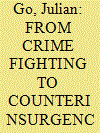

|
|
|
|
|
| Summary/Abstract |
The Special Patrol Group (SPG) of the London Metropolitan Police was formed as a crime-fighting unit in 1965. Beginning in the early 1970s, however, it underwent a transformation of ‘colonial counterinsurgenization’. The SPG shifted its initial role and increasingly took on the characteristics of a colonial counterinsurgency police force operating in the metropolis. The change is seen in the SPG’s approach to public order policing and crime prevention, especially in London’s African-Caribbean communities. The new counterinsurgency tactics of the SPG in those communities in turn generated the conditions for the very sorts of metropolitan uprisings the SPG had sought to subdue.
|
|
|
|
|
|
|
|
|
|
|
|
|
|
|
|
| 3 |
ID:
185081


|
|
|
|
|
| Summary/Abstract |
Taking the Capitol riots of January 6 as a point of departure, this article queries the utility of abject white violence to the US security state through a focus on the latest push for domestic terrorism legislation. Drawing on the first-ever National Strategy for Countering Domestic Terrorism released by the White House in June 2021, we trace how the US security state constructs white supremacist violence as both abject and anachronistic, a creative project of history-making through which the liberal security state operationalizes that violence to bolster and expand US empire and counterinsurgency. Further, we explore how the fungibility of abject whiteness within contemporary US counterterrorism creates a metonymic power by which the foreign and domestic cohere, collapse, and diverge through the figure of the racialized terrorist to suit the needs of the imperial state. While the state’s current push for domestic terrorism legislation publicly portrays a stance of historical reconciliation and multicultural protectionism, the figure of the domestic terrorist functions as a conduit through which the violence of the state is rerouted. Through this vision of besieged multiculturalism, the liberal security state seeks to creatively refashion US empire domestically and at the global scale.
|
|
|
|
|
|
|
|
|
|
|
|
|
|
|
|
| 4 |
ID:
185068


|
|
|
|
|
| Summary/Abstract |
This introduction to the special issue ”Global Counterinsurgency and the Police-Military Continuum” examines the emergence of global counterinsurgency in the twentieth century and introduces the critical concept of the police-military continuum. Through a review of the recent literature, it also provides a framework for analyzing the relationship of historical trends and contemporary developments in what is typically labeled ”police militarization.” It introduces and summarizes the fourteen original research articles in the special issue, which analyze United States, United Kingdom, Costa Rica, Haiti, India, Kenya, Malaysia, Tanganyika, and elsewhere. The introduction explains the genesis of the special issue in the aftermath of the rebellions of 2020, and it also considers new directions for research in the aftermath of the events of 6 January 2021 at the US Capitol, as well as what these events indicate about counterinsurgency’s possible future mutations.
|
|
|
|
|
|
|
|
|
|
|
|
|
|
|
|
| 5 |
ID:
185076
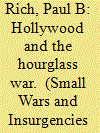

|
|
|
|
|
| Summary/Abstract |
This paper examines the cinema of the US-Mexican border in the context of an escalating drug war. It looks at movies released since the early 1980s and argues that Hollywood has supplied a large number of cinematic images of the ‘war on drugs’ that has more helped shape wider political and strategic debates. Using insights from strategic analysis, this paper seeks to show how cinema has represented the conflict between drug cartels, the Mexican state as well as various US security agencies such as the FBI, CIA, and DEA. The paper explores how these cinematic depictions straddle national boundaries and have evolved from being an extension of the western border genre in the 1980s into a more recent phase of action and war movies.
|
|
|
|
|
|
|
|
|
|
|
|
|
|
|
|
| 6 |
ID:
185069


|
|
|
|
|
| Summary/Abstract |
In analyzing West German police assistance for Costa Rica, we uncover the transnational dynamics of Cold War counterinsurgency policing during the Central American conflicts of the 1980s. We scrutinize West Germany’s engagements with Costa Rica, demonstrating how technical police assistance by the self-fashioned West German ‘civilian power’ fed into a wider counterinsurgency turn in Costa Rican policing. Highlighting the role of local agency and transnational context conditions, we point towards the interest of the Costa Rican government in reaching out to West Germany to demonstrate its neutrality within the ongoing conflicts while simultaneously bolstering the counterinsurgency capacities of its police forces.
|
|
|
|
|
|
|
|
|
|
|
|
|
|
|
|
| 7 |
ID:
185077


|
|
|
|
|
| Summary/Abstract |
Within recent critical debates about the geographies and circulations of counterinsurgency knowledge, scholars have focused primarily on dominant centres of power and authority in the global North. Building a framework drawn from critical geography, this article decentres these locations and actors by exploring the global production and circulation of counterinsurgency knowledge from the vantage point of Indian strategic thinkers. Focusing on the work of the Indian think tank the Institute for Conflict Management (ICM), the article traces how Indian counterinsurgency knowledge has been produced, packaged and circulated transnationally since the late 1990s. It argues the power and utility that forms of counterinsurgency knowledge command – Indian or otherwise – are never reducible to the essential features of what actors or texts say. Rather, it suggests that counterinsurgency knowledge is produced through particular relations and locations of power-knowledge that define what they represent and where they fit in. It theorizes forms of counterinsurgency knowledge as positions within broader transnational forces, entwined with colonial histories of pacification. In doing so, it illuminates the contestations and forms of work involved in staging or organizing the world through practices that make some forms, actors, and locations important and relegate others to the peripheries of global politics.
|
|
|
|
|
|
|
|
|
|
|
|
|
|
|
|
| 8 |
ID:
185078
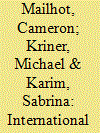

|
|
|
|
|
| Summary/Abstract |
The US and UN are two of the largest patrons of police reform programs worldwide: between 2000 and 2020, the US provided approximately $160 billion in police assistance to more than 130 countries worldwide; simultaneously, the UN spent over $77 billion supplying police-oriented security sector reform to countries experiencing or having experienced armed conflict, doing so through the deployment of peacekeeping missions and within the offices of UN Police, the UN’s hub for police reform and training programs. Though these two providers seek the same overall objective, they often vary in their specific goals: the US often engages in foreign police reform to promote its own national security objectives by increasing institutional capacity, while the UN adopts police reform programs to promote institutional constraint. The two models have important implications for how we understand bilateral and multilateral reform programs, including activities performed and recipient countries targeted across both time and space. Using originally collected data on US security assistance programs as well as a careful analysis of original data on UN mandates, this article provides the first quantitative exploration of these two different modes of assistance, comparing and contrasting their objectives and where, when, and how they are provided.
|
|
|
|
|
|
|
|
|
|
|
|
|
|
|
|
| 9 |
ID:
185079
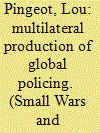

|
|
|
|
|
| Summary/Abstract |
This article argues that UN peace operations play a central role in the nexus between policing and counterinsurgency, and constitute one of the underappreciated sites and circuits of counterinsurgent knowledge. It posits that the convergence between peace operations and counterinsurgency has been driven not only (or even primarily) by these mission’s more assertive military posture under ‘stabilization’, but also by the turn to ‘polickeeping’, the growing role of police forces and increasing importance of policing tasks in peacekeeping. The stabilization/policekeeping mindset rests on the assumption of a continuum from minor instances of disorders to full-blown armed conflict, leading to an expansive understanding of what may constitute a threat to stability and require international intervention. The articles teases out the macro and micro manifestations of this mindset through the lens of UN peace operations’ response to civil unrest and demonstrations. It shows that, because peace operations are a point of cross-fertilization for the creation and transmission of global policing practices, UN protest policing reverberates beyond the specific countries in which peace operations are deployed. Peace operations create a global demand for and supply of specific skills and tools, in particular paramilitary police forces.
|
|
|
|
|
|
|
|
|
|
|
|
|
|
|
|
| 10 |
ID:
185072
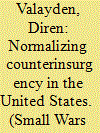

|
|
|
|
|
| Summary/Abstract |
In this article, I elaborate on the thesis that counterinsurgency has become a ‘new governing paradigm’ in the United States. I first argue that the DoD redefinition of terrorism blurred the conceptual boundaries between counterterrorism and counterinsurgency, to ease the latter’s transition from the field of military strategy to that of political governance. Second, I argue that counterinsurgency became a governing paradigm, based on political techniques that worked through the subjective capabilities of the population. After 9/11, those capabilities were associated with the first responder. I trace the conceptual evolution of the first responder as a technical category in the discourse and administration of public safety, to its re-emergence in the concept of homeland security after 9/11. I argue that the political architecture created by homeland security emphasized the awareness, preparedness and resilience of the first responder who was in turn defined as the first line of defense against potential attacks. Through the first responder, counterinsurgency achieves its fundamental goal: to prevent social transformation by securing societal ‘normalcy’. Lastly, I argue that, as a governing paradigm, counterinsurgency provides a frame of interpretation to understand and categorize social experience: a first responders/insurgents schism now guides how we interpret political divisions.
|
|
|
|
|
|
|
|
|
|
|
|
|
|
|
|
| 11 |
ID:
185080
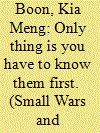

|
|
|
|
|
| Summary/Abstract |
This article critically examines the models of protest policing deployed by the Malaysian police during the BERSIH 2.0 wave of protests (2011–2016). Based on participant observation and critical ethnography of these protest events, it explains how the state and police adapted to the surge of street protests in Kuala Lumpur by bringing together various elements of policing practices in its attempt to contain dissent on the streets. I argue that the new ‘Peaceful Assembly assemblage’ of policing practices, though distinct and significantly different in its overall governing logic compared to its predecessor, it remains heavily connected to late colonial forms of public order and counterinsurgent policing, especially the Special Branch and the Federal Reserve Unit (riot police). In this sense, the article shows that colonial policing’s afterlife is a major factor for understanding how Malaysia’s protest policing experience complicates and departs from patterns of protest policing development observed in the Global North.
|
|
|
|
|
|
|
|
|
|
|
|
|
|
|
|
| 12 |
ID:
185070
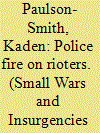

|
|
|
|
|
| Summary/Abstract |
Many have shown how ‘the British way’, a doctrine of minimum force, was problematic in theory and practice, especially in the final decades of empire. While the role of the colonial police in suppressing uprisings is often overlooked, this article argues that the police carried out everyday counterinsurgency campaigns. Using British archival records, this article examines a 1950 dockworker strike in Dar es Salaam, the colonial capital of former Tanganyika. Workers’ resistance was perceived by colonial authorities as insurgency, which led to the crosspollination of new policing strategies throughout the British Empire to expand surveillance, control riots, and break strikes.
|
|
|
|
|
|
|
|
|
|
|
|
|
|
|
|
| 13 |
ID:
185075
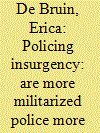

|
|
|
|
|
| Summary/Abstract |
Is militarized policing an effective way to combat insurgency? This article uses new global data on policing practices to evaluate whether states with militarized police perform better than those without them. The analysis provides no evidence that militarized police are an asset in counterinsurgency. Indeed, states with militarized units within their national or federal-level police are generally less likely to achieve favorable counterinsurgency outcomes. In explaining these findings, the article emphasizes that while militarization provides police with greater coercive capacity, it also impedes information collection and contributes to indiscriminate violence that can fuel additional dissent.
|
|
|
|
|
|
|
|
|
|
|
|
|
|
|
|
| 14 |
ID:
185073


|
|
|
|
|
| Summary/Abstract |
This paper reveals the secrets of BlueLeaks, a massive archive of documents hacked from police agencies, and intelligence centers in the United States. A September 2019 Intelligence Assessment by the Virginia Fusion Center cites counterinsurgency expert David Kilcullen to evaluate the ‘insurgency tactics and strategies’ of environmentalists. What is remarkable about the document is not the domestic application of counterinsurgency but how it reveals the biases of security. Read from an anti-security perspective, this document becomes a cipher to decode the political content of the BlueLeaks archive that is obscured by the deep acceptance of ‘security’ as an apolitical, unqualified social good. The analysis is grounded in document and network analysis of BlueLeaks documents from the New England region. It finds that practices commonly understood as ‘counterinsurgency’ span and animate the continuum of pacification. The secret of BlueLeaks is the secret of security: a ceaseless low-intensity class war that envelops and encompasses the continuum of pacification, protects property, administers poverty, depoliticizes social harms, and elicits participation in pacification.
|
|
|
|
|
|
|
|
|
|
|
|
|
|
|
|
|
|
|
|
|